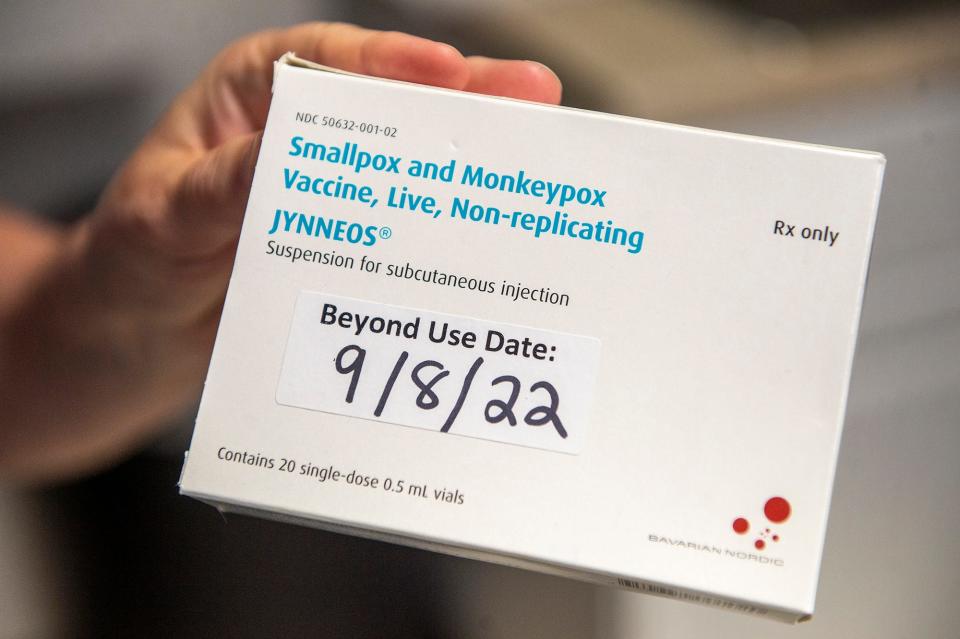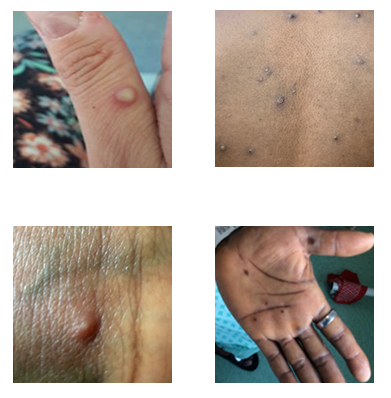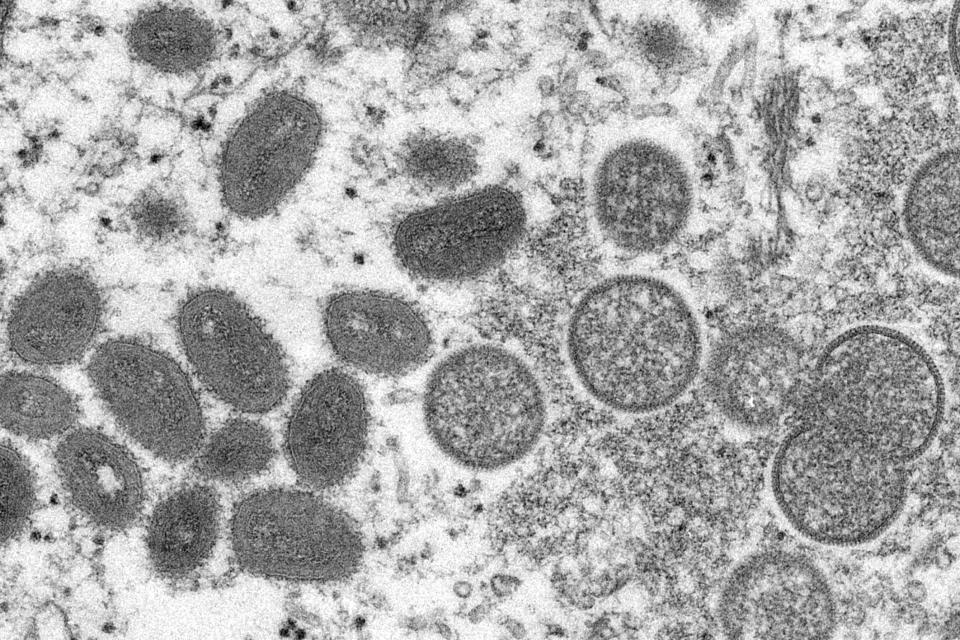Monkeypox: Are vaccines available in Palm Springs? What does it look like? Answers to your questions
As more monkeypox cases emerge locally — there have been at least 18 probable and confirmed cases reported in Riverside County as of Tuesday — many Coachella Valley residents might wonder how they can best protect themselves, including how to get their hands on vaccines.
Vaccine supply to Riverside County has been scarce, but Coachella Valley clinics are starting to receive doses. At this time, however, distribution has been limited to high-risk patients, including those with known monkeypox exposures.
Here are answers to some of your most pressing monkeypox questions.
Read more:
What Californians need to know about the monkeypox virus outbreak
Addressing myths about monkeypox: A look at symptoms, treatment and other common questions
Where does monkeypox come from?
Monkeypox is a rare disease caused by the monkeypox virus. It was discovered in 1958 when two outbreaks of a pox-like disease occurred among colonies of research monkeys, according to the CDC. Although it is named “monkeypox,” the CDC states the source of the disease is still unknown (though African rodents and non-human primates, like monkeys, might harbor the virus and infect people).
The first human case was reported in 1970 in the Democratic Republic of Congo, according to the CDC.
The virus is usually found in Central and West Africa and does not occur naturally in the U.S., but recent national cases have been discovered due to international travel or animals imported from areas where the disease is more common.
Are monkeypox vaccines available in the Palm Springs area? How can I get one?
Here is a look at vaccine supply by health care provider:
Borrego Health has received approximately 100 vaccine doses, according to spokesperson Dan Kramer.
Vaccine demand has been high, especially for high-risk patients, but at this time, the health care organization has only been able to offer vaccines to high-risk Borrego Health patients. The ultimate goal is to open it up to non-Borrego Health patient, said Kramer, similar to COVID-19 vaccine distribution. He added they will be utilizing the same workflow once more vaccines are allocated in the coming weeks.
Borrego Health is in the process of applying for a supply of TPOXX from the Centers for Disease Control and Prevention under the Expanded Access‐Investigational New Drug program. Tecovirimat, or TPOXX, a medication approved by the FDA for smallpox but not monkeypox, is available in oral form (three pills taken twice a day for two weeks) or an IV. The medication would be provided to Borrego Health from the Strategic National Stockpile, via the Regional Medical Health System and Medical Health Operational Area Coordination program, said Kramer.
DAP Health has received 160 doses of the vaccine.
As of Tuesday morning, 110 of 160 doses have been administered or are scheduled to be administered within the next 24 hours, according to CJ Tobe, director of Community Health and Sexual Wellness. All 160 vaccines are expected to be administered by the end of Thursday. The Palm Springs-based clinic has not received a timeline as to when second-dose vaccines will be provided.
When it comes to distribution, DAP Health has been prioritizing staff members who have handled testing or specimens; individuals who have a known exposure and don't have symptoms currently; patients who have had a bacterial sexually transmitted infection (syphilis and gonorrhea) in the last three months (there are 654 patients who meet this criteria); those engaging in sex work, massage therapy or ongoing group sex. Research over the last few weeks has identified at least 177 sex workers who are visibly advertising services and more than 30 publicized scheduled group sex events in the Palm Springs area, said Tobe, but those numbers are likely low.
If thousands more vaccines become available to DAP Health, Tobe said he would like to hold vaccination clinics to get shots in as many people's arms as possible.
Eisenhower Health received 120 doses for patients who have had a high-risk exposure to the disease.
Eisenhower Health will prioritize patients with a confirmed or possible high-risk exposure within the last 14 days. Priority also will be given to higher-risk patients, including those with HIV, and to patients with exposures in the past four days because treatment is most effective immediately following exposure.
As additional allotments from the CDC arrive, Eisenhower Health will expand access as much as possible, with the goal to serve more people in the community.

Local hospitals such as Desert Regional Medical Center in Palm Springs, JFK Memorial in Indio and Hi-Desert Medical Center in Joshua Tree do not have monkeypox vaccines available at this time, said spokesperson Richard Ramhoff.
The Desert Healthcare District has also not received vaccines. Spokesperson Will Dean said "when ample doses become available for the Coachella Valley, the Desert Healthcare District will work with and assist Riverside County Public Health and other community partners in implementing an equitable distribution plan that helps ensure protection from monkeypox is available to all at-risk residents."
Riverside County has received more than 1,000 post-exposure vaccines for monkeypox, which would help protect 500-plus people most at risk of infection, county spokesperson Jose Arballo Jr. told The Desert Sun.
The county is expecting more doses to come in, but Arballo said earlier this month there was no estimate as to when they might arrive. Riverside County Public Health will maintain a supply of the monkeypox vaccine that could be used in the event of a large-scale exposure event. In terms of distribution, it will provide the vaccine to people who have been in close contact with someone who has had monkeypox who are identified by public health via case investigation, contact tracing and risk exposure assessments.
What vaccine is used?
The Jynneos vaccine, approved in 2019 by the Food and Drug Administration for the prevention of smallpox and monkeypox in people ages 18 and older, requires two doses, four weeks apart. The Centers for Disease Control and Prevention is also investigating a measure to allow the vaccine to be used in children. In addition to possibly preventing monkeypox, the vaccine may also lessen symptoms in people who have been exposed.

What does monkeypox look like? What does it do to you?
Monkeypox is known for its multi-stage rash. The CDC states the rash can look like pimples or blisters that appears on the face, inside the mouth, hands, feet, chest, genitals or anus. The rash, which can leave scars, goes through a number of stages before healing: macular (flat) to papular (raised) to vesicular (raised and filled with clear fluid) to pustular (filled with opaque fluid). These itchy lesions will scab over and remain on the body for about a week before they fall off. Once all scabs have fallen off a person is no longer contagious, according to the CDC. To read more about the rash and lesions, visit https://www.cdc.gov/poxvirus/monkeypox/clinicians/clinical-recognition.html
Other symptoms of monkeypox may include fever, headache, muscle aches and backache, swollen lymph nodes, sore throat, chills and exhaustion. Though not common, severe complications may include diarrhea or vomiting.
How is the virus transmitted?
Monkeypox can be spread in a number of ways:
Direct contact with rash, scabs or body fluids
Respiratory secretions during prolonged face-to-face contact or intimate physical contact, such as kissing, cuddling or sex
Touching items like clothing or linens that previously touched an infected individual's rash or body fluids
Pregnant people can spread the virus to their fetus through the placenta
Being scratched or bitten by an infected animal, or by preparing, eating meat or using products from infected animals.
The CDC states it is not known if monkeypox can spread through semen or vaginal fluids.
More: Palm Springs isn't getting enough monkeypox vaccines, say DAP Health and Rep. Raul Ruiz

How can I get tested for monkeypox?
Contact your health care provider if you suspect you've been exposed to monkeypox. Barbara Cole, the county's director of disease control, previously told The Desert Sun the provider will perform an assessment to determine if an individual needs to be tested for the virus, report to Riverside County Public Health and then the health department would coordinate next steps.
More: Palm Springs mayor calls on CDC, CDPH to shift strategies with monkeypox vaccines
How long does monkeypox live on surfaces?
Studies have found that the virus can live on surfaces for as long as 15 days, and other closely related orthopoxviruses can survive for weeks or months. Regularly disinfecting all areas of an individual's home and car is recommended. Visit https://www.cdc.gov/poxvirus/monkeypox/specific-settings/home-disinfection.html for more information.
USA Today contributed to this report.
Ema Sasic covers entertainment and health in the Coachella Valley. Reach her at ema.sasic@desertsun.com or on Twitter @ema_sasic.
This article originally appeared on Palm Springs Desert Sun: Monkeypox in Palm Springs: Where to get vaccines; what are symptoms?

